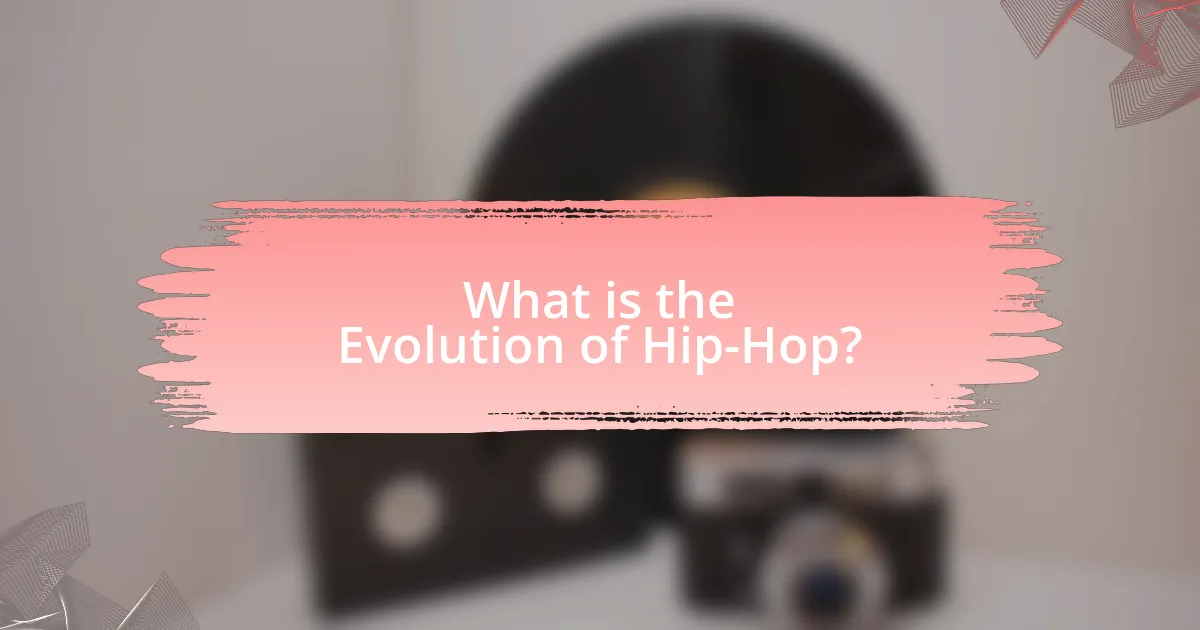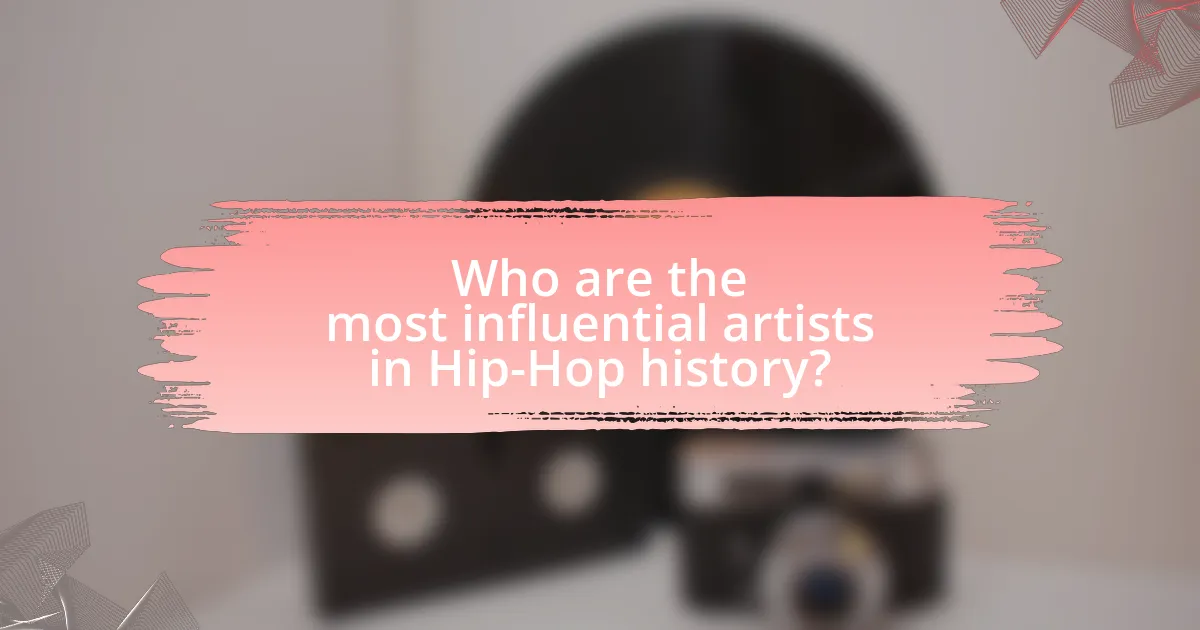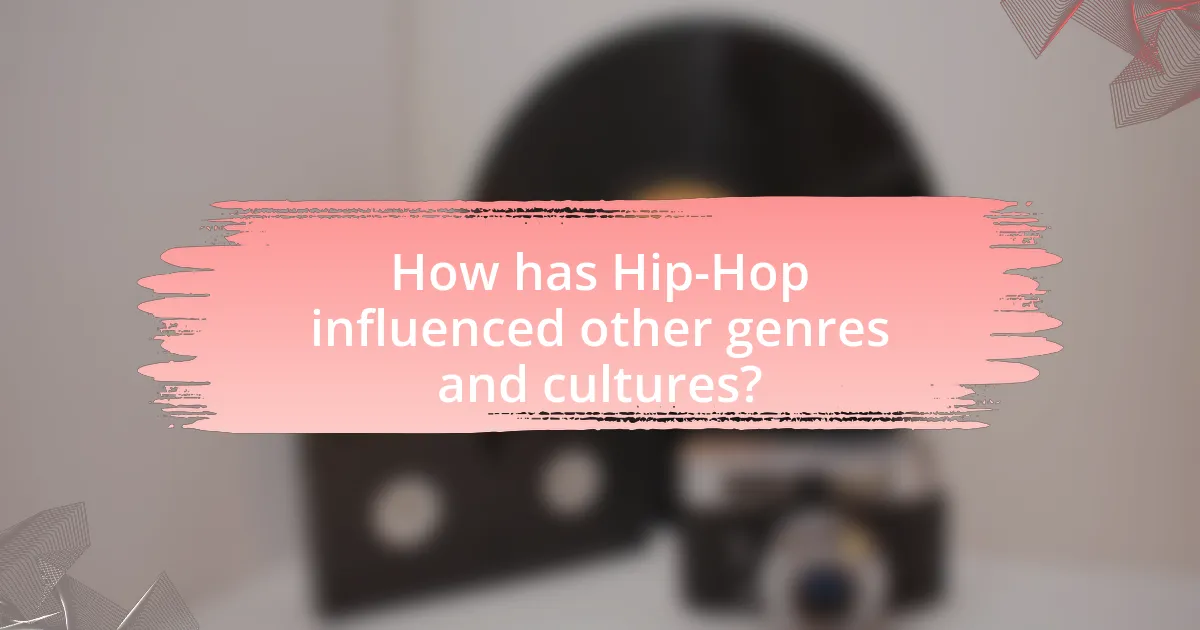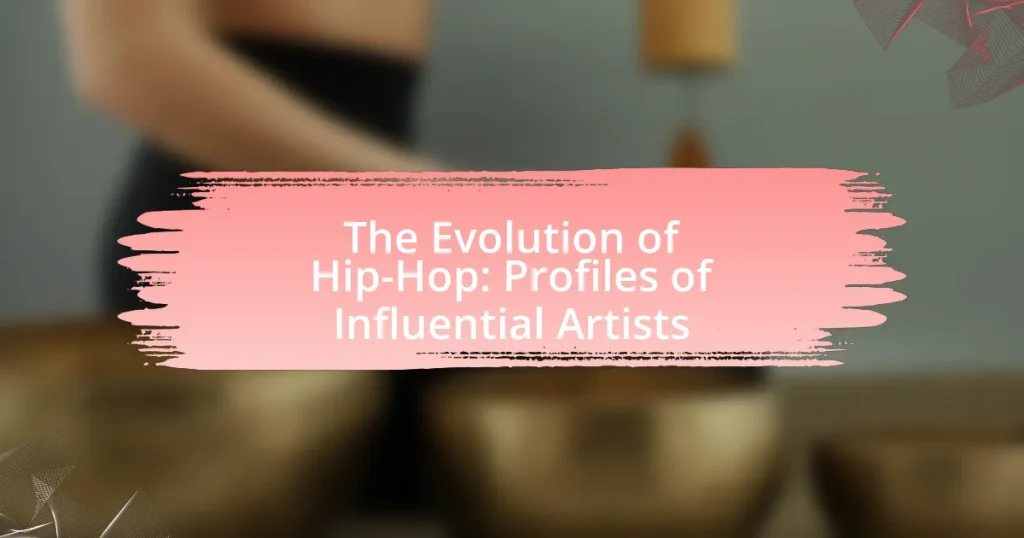The article focuses on the evolution of hip-hop, tracing its origins from the 1970s in the Bronx, New York City, where pioneers like DJ Kool Herc and Grandmaster Flash laid the groundwork for the genre. It highlights key phases in hip-hop’s development, including the foundational period, the golden age, the mainstream explosion, and the digital age, while examining the cultural and social factors that influenced its growth. The article profiles influential artists such as Tupac Shakur, The Notorious B.I.G., Jay-Z, Kendrick Lamar, and Nicki Minaj, detailing their contributions to the genre and the impact of their work on hip-hop culture and society. Additionally, it discusses the genre’s global influence, cross-genre collaborations, and future trends shaped by technology and emerging artists.

What is the Evolution of Hip-Hop?
The evolution of hip-hop began in the 1970s in the Bronx, New York City, where DJs like Kool Herc pioneered the use of breakbeats to create a new musical genre. This foundational period saw the emergence of rapping as a vocal style, with artists such as Grandmaster Flash and the Furious Five gaining prominence. In the 1980s, hip-hop expanded nationally, with the release of influential albums like Run-D.M.C.’s self-titled debut and the Beastie Boys’ “Licensed to Ill,” which introduced hip-hop to a broader audience.
The 1990s marked a significant diversification of hip-hop, with the rise of subgenres such as gangsta rap, led by artists like Tupac Shakur and The Notorious B.I.G., who addressed social issues and personal narratives in their lyrics. This era also saw the establishment of iconic record labels like Death Row Records and Bad Boy Entertainment, which played crucial roles in shaping the sound and culture of hip-hop.
In the 2000s and beyond, hip-hop continued to evolve, incorporating elements from various genres and becoming a dominant force in global music. Artists like Jay-Z, Eminem, and Kanye West pushed creative boundaries, while the rise of digital platforms transformed how music was distributed and consumed. Today, hip-hop remains a powerful cultural movement, influencing fashion, language, and social issues worldwide.
How did Hip-Hop originate and develop over time?
Hip-Hop originated in the 1970s in the South Bronx, New York City, primarily as a cultural movement among African American and Latino youth. It developed through four key elements: rapping (MCing), DJing, graffiti art, and breakdancing. The genre gained popularity with the release of influential tracks like “Rapper’s Delight” by the Sugarhill Gang in 1979, which is often credited as the first commercially successful hip-hop song. Over the years, Hip-Hop evolved through various styles and subgenres, influenced by social issues, technological advancements, and regional sounds, leading to its global prominence by the 1990s and 2000s. The genre has since diversified, incorporating elements from other musical styles and addressing a wide range of themes, solidifying its place in contemporary music and culture.
What cultural and social factors influenced the birth of Hip-Hop?
The birth of Hip-Hop was influenced by cultural and social factors such as the African American experience, urbanization, and socio-economic challenges in the 1970s. The genre emerged in the South Bronx, where marginalized communities faced poverty, crime, and systemic racism, leading to a need for self-expression and identity. Block parties and DJing became popular as a means of community gathering, fostering creativity through music, dance, and art. The use of sampling from funk, soul, and disco records provided a musical foundation, while graffiti art served as a visual representation of the culture. These elements combined to create a vibrant scene that reflected the struggles and aspirations of the youth, ultimately giving rise to Hip-Hop as a powerful cultural movement.
How did the early styles of Hip-Hop shape its future?
The early styles of Hip-Hop laid the foundation for its future by establishing key elements such as rhythm, lyricism, and cultural expression. These foundational aspects influenced subsequent genres and artists, creating a diverse landscape that incorporated various musical styles and social messages. For instance, the use of breakbeats and sampling in the 1970s and 1980s allowed for innovative production techniques that are still prevalent today. Additionally, the storytelling and social commentary found in early Hip-Hop tracks addressed issues like poverty and inequality, setting a precedent for future artists to explore similar themes. This evolution is evident in the works of influential artists like Grandmaster Flash and Afrika Bambaataa, whose contributions helped shape the genre’s trajectory and cultural significance.
What are the key phases in the evolution of Hip-Hop?
The key phases in the evolution of Hip-Hop include the foundational phase (1970s), the golden age (1980s to early 1990s), the mainstream explosion (mid-1990s to early 2000s), and the digital age (2000s to present). The foundational phase established Hip-Hop culture through block parties and DJing, with pioneers like DJ Kool Herc and Afrika Bambaataa. The golden age saw innovation in lyrical complexity and production, featuring artists like Run-D.M.C. and Public Enemy. The mainstream explosion brought Hip-Hop into the commercial spotlight, with artists like Tupac Shakur and The Notorious B.I.G. leading the way. Finally, the digital age has transformed distribution and consumption, with platforms like YouTube and streaming services reshaping how artists connect with audiences. Each phase reflects significant cultural and technological shifts that have shaped Hip-Hop’s trajectory.
What characterized the Golden Age of Hip-Hop?
The Golden Age of Hip-Hop is characterized by innovation, diversity, and lyrical complexity. This period, roughly from the mid-1980s to the early 1990s, saw the emergence of influential artists such as Public Enemy, A Tribe Called Quest, and Nas, who pushed the boundaries of the genre. The era is marked by the introduction of new production techniques, including sampling and the use of live instrumentation, which enriched the sound of hip-hop. Additionally, the lyrical content became more sophisticated, addressing social issues, personal narratives, and cultural commentary, as exemplified in tracks like “Fight the Power” by Public Enemy and “The Message” by Grandmaster Flash and the Furious Five. This combination of artistic growth and cultural relevance solidified the Golden Age as a pivotal moment in hip-hop history.
How did the commercialization of Hip-Hop impact its evolution?
The commercialization of Hip-Hop significantly transformed its evolution by introducing mainstream appeal and altering its artistic direction. As record labels began to invest heavily in Hip-Hop during the late 1980s and 1990s, artists gained access to larger audiences and increased financial resources, which led to the production of more polished and commercially viable music. For instance, the success of artists like Run-D.M.C. and later Tupac Shakur and The Notorious B.I.G. exemplified how commercial success could elevate Hip-Hop’s status in popular culture. This shift also encouraged the incorporation of diverse musical styles and themes, as artists sought to appeal to broader demographics, resulting in sub-genres like gangsta rap and pop-rap. Consequently, the commercialization of Hip-Hop not only expanded its reach but also influenced its lyrical content and production techniques, shaping the genre into a dominant force in the music industry.
Why is understanding the evolution of Hip-Hop important?
Understanding the evolution of Hip-Hop is important because it provides insight into the cultural, social, and political contexts that shaped the genre. Hip-Hop emerged in the 1970s in the Bronx, reflecting the struggles and aspirations of marginalized communities. This historical backdrop reveals how artists like Grandmaster Flash and Afrika Bambaataa used music as a form of resistance and expression. Additionally, the evolution showcases the genre’s adaptability, influencing and being influenced by various musical styles, which highlights its role in broader cultural movements. For instance, the rise of socially conscious rap in the 1980s, exemplified by Public Enemy, underscores Hip-Hop’s capacity to address systemic issues. Understanding these dynamics is crucial for appreciating the genre’s impact on society and its ongoing relevance in contemporary discourse.
How does the evolution of Hip-Hop reflect broader societal changes?
The evolution of Hip-Hop reflects broader societal changes by serving as a mirror to cultural, political, and economic shifts within communities. For instance, the genre emerged in the 1970s in the Bronx, New York, as a response to urban decay, economic hardship, and social inequality, highlighting issues such as poverty and systemic racism. As Hip-Hop progressed into the 1980s and 1990s, artists like Public Enemy and N.W.A addressed social injustices and police brutality, resonating with the civil rights movements of the time. Furthermore, the commercialization of Hip-Hop in the 2000s illustrated the impact of globalization and consumer culture, as artists like Jay-Z and Kanye West transitioned from local voices to global icons, reflecting changing dynamics in media and technology. This trajectory underscores how Hip-Hop not only adapts to but also influences societal narratives, making it a significant cultural barometer.
What lessons can be learned from the history of Hip-Hop?
The history of Hip-Hop teaches the importance of cultural expression, resilience, and social commentary. Hip-Hop emerged in the 1970s as a response to socio-economic challenges faced by marginalized communities, particularly in the Bronx, New York. Artists like Grandmaster Flash and Afrika Bambaataa utilized music and dance to address issues such as poverty, violence, and systemic racism, demonstrating how art can serve as a powerful tool for activism and change. Furthermore, the genre’s evolution showcases the significance of innovation and collaboration, as seen in the diverse styles and sub-genres that have developed over the decades, from East Coast to West Coast rap. This adaptability highlights the necessity of embracing change and creativity in any artistic endeavor.

Who are the most influential artists in Hip-Hop history?
The most influential artists in Hip-Hop history include Tupac Shakur, The Notorious B.I.G., Jay-Z, Nas, and Kendrick Lamar. Tupac Shakur, known for his profound lyrics and social commentary, has sold over 75 million records worldwide, making him a cultural icon. The Notorious B.I.G. revolutionized storytelling in rap with his debut album “Ready to Die,” which has been certified quadruple platinum. Jay-Z, with 14 Grammy Awards and over 50 million albums sold, has significantly impacted the business side of Hip-Hop. Nas’s album “Illmatic” is often cited as one of the greatest albums of all time, influencing countless artists. Kendrick Lamar, a Pulitzer Prize winner, has pushed the boundaries of the genre with his innovative storytelling and social critique, exemplified in his album “To Pimp a Butterfly.” These artists have shaped the sound, culture, and perception of Hip-Hop, leaving a lasting legacy.
What contributions did pioneers like DJ Kool Herc and Grandmaster Flash make?
DJ Kool Herc and Grandmaster Flash significantly shaped the foundations of hip-hop music and culture. DJ Kool Herc is credited with developing the breakbeat technique, which involved isolating and extending the instrumental portions of songs to create a continuous dance rhythm, thus laying the groundwork for hip-hop DJing. Grandmaster Flash further innovated this art form by introducing techniques such as backspinning and punch phrasing, which enhanced the live performance experience and allowed for more complex mixing. Their contributions not only defined the role of the DJ in hip-hop but also influenced the genre’s evolution, making them pivotal figures in its history.
How did DJ Kool Herc’s techniques shape the sound of Hip-Hop?
DJ Kool Herc’s techniques fundamentally shaped the sound of Hip-Hop by introducing the breakbeat, which emphasized the instrumental sections of songs. His innovative use of two turntables allowed him to extend these breaks, creating a continuous loop that became the backbone of Hip-Hop music. This technique not only laid the groundwork for DJing but also influenced the rhythmic style of rapping, as MCs began to rhyme over these extended beats. Herc’s approach to mixing and his focus on the danceable elements of music helped establish the energetic and rhythmic foundation that defines Hip-Hop today.
What innovations did Grandmaster Flash introduce to the genre?
Grandmaster Flash introduced several key innovations to hip-hop, notably the technique of “backspinning,” which allowed DJs to repeat specific sections of a record seamlessly. This technique enhanced the live performance aspect of hip-hop, enabling a more dynamic and engaging experience for audiences. Additionally, he developed the “cutting” technique, which involved quickly switching between two records to create rhythmic patterns and beats, further enriching the sound of hip-hop. Flash’s pioneering use of the turntable as an instrument laid the groundwork for future DJs and producers, solidifying his influence on the genre’s evolution.
How did artists like Tupac Shakur and The Notorious B.I.G. redefine Hip-Hop?
Tupac Shakur and The Notorious B.I.G. redefined Hip-Hop by introducing complex narratives that addressed social issues, personal struggles, and the realities of urban life. Tupac’s lyrics often explored themes of racial inequality, poverty, and violence, exemplified in songs like “Changes” and “Keep Ya Head Up,” which resonated with a wide audience and highlighted systemic injustices. Similarly, The Notorious B.I.G. brought a storytelling approach to his music, using vivid imagery and relatable experiences in tracks like “Juicy” and “Big Poppa,” which showcased the aspirational aspects of life while also reflecting the harsh realities of street culture. Their contributions elevated Hip-Hop from mere entertainment to a powerful medium for social commentary, influencing countless artists and shaping the genre’s evolution.
What themes did Tupac explore in his music that resonated with audiences?
Tupac explored themes of social injustice, poverty, violence, and resilience in his music, which resonated deeply with audiences. His lyrics often addressed systemic racism and the struggles faced by marginalized communities, as seen in songs like “Brenda’s Got a Baby,” which highlights the challenges of young women in impoverished environments. Additionally, Tupac’s candid discussions about personal pain and emotional vulnerability in tracks such as “Dear Mama” fostered a connection with listeners who experienced similar hardships. His ability to articulate the complexities of life in urban America, combined with his poetic style, solidified his impact and relevance in hip-hop culture.
How did The Notorious B.I.G.’s storytelling influence Hip-Hop culture?
The Notorious B.I.G.’s storytelling significantly influenced Hip-Hop culture by elevating narrative depth and authenticity in lyrics. His ability to weave intricate tales of street life, personal struggles, and triumphs resonated with listeners, setting a new standard for lyrical content. For instance, songs like “Juicy” and “Sky’s the Limit” showcase his skill in blending autobiographical elements with universal themes, making his experiences relatable to a broader audience. This approach not only inspired a generation of artists to prioritize storytelling in their music but also contributed to the genre’s evolution by emphasizing the importance of personal narrative and emotional connection in Hip-Hop.
What impact did contemporary artists like Kendrick Lamar and Nicki Minaj have on Hip-Hop?
Contemporary artists like Kendrick Lamar and Nicki Minaj have significantly impacted Hip-Hop by pushing the boundaries of lyrical content and representation. Kendrick Lamar’s work, particularly in albums like “To Pimp a Butterfly,” addresses complex social issues such as race, identity, and mental health, earning him critical acclaim and a Pulitzer Prize for Music in 2018. Nicki Minaj has redefined female representation in the genre, showcasing versatility and empowerment through her diverse musical styles and strong persona, which has led to her being one of the best-selling female rappers of all time. Their contributions have not only elevated the artistic quality of Hip-Hop but also expanded its cultural relevance, influencing a new generation of artists and listeners.
How has Kendrick Lamar’s lyrical content pushed boundaries in Hip-Hop?
Kendrick Lamar’s lyrical content has pushed boundaries in Hip-Hop by addressing complex social issues such as systemic racism, mental health, and personal identity. His album “To Pimp a Butterfly” exemplifies this, as it explores the African American experience and critiques societal norms through intricate storytelling and poetic devices. Lamar’s use of varied musical styles and innovative structures in his songs, such as the incorporation of jazz and spoken word, further challenges traditional Hip-Hop conventions. His candid discussions about his own struggles with depression and self-worth in tracks like “u” and “Fear.” provide a raw, introspective perspective that is often absent in mainstream Hip-Hop, thereby expanding the genre’s thematic scope.
What role has Nicki Minaj played in shaping the representation of women in Hip-Hop?
Nicki Minaj has played a pivotal role in shaping the representation of women in Hip-Hop by challenging gender norms and promoting female empowerment. As one of the first female rappers to achieve mainstream success, she has utilized her platform to advocate for women’s rights and assert their presence in a male-dominated industry. Her bold persona and diverse musical styles have redefined femininity in Hip-Hop, allowing for a broader range of expressions among female artists. For instance, her 2010 debut album “Pink Friday” debuted at number one on the Billboard 200, showcasing her commercial viability and influence. Additionally, Minaj’s collaborations with other female artists, such as Beyoncé and Ariana Grande, have further elevated women’s visibility in the genre, encouraging collaboration over competition.

How has Hip-Hop influenced other genres and cultures?
Hip-Hop has significantly influenced other genres and cultures by integrating elements such as rhythm, lyrical storytelling, and sampling techniques. This genre has impacted pop music, with artists like Drake and Cardi B incorporating Hip-Hop beats and flows into their songs, leading to chart-topping hits that blend styles. Additionally, Hip-Hop has shaped fashion trends, language, and social movements, promoting cultural expressions that resonate globally. For instance, the rise of streetwear brands like Supreme and Off-White reflects Hip-Hop’s influence on fashion, while the Black Lives Matter movement has been amplified through Hip-Hop artists using their platforms to address social justice issues. The genre’s global reach is evident in the emergence of international Hip-Hop scenes, such as K-Pop artists like BTS, who incorporate Hip-Hop elements into their music, further demonstrating its pervasive influence across cultures.
What cross-genre collaborations have emerged from Hip-Hop?
Cross-genre collaborations that have emerged from Hip-Hop include notable partnerships such as Run-D.M.C. with Aerosmith on “Walk This Way,” which blended rock and rap, and Lil Nas X’s “Old Town Road,” which fused country and Hip-Hop elements. These collaborations have significantly impacted music charts, with “Walk This Way” reaching No. 1 on the Billboard Hot 100 in 1986, and “Old Town Road” achieving a record-breaking 19 weeks at No. 1 in 2019. Other examples include Jay-Z’s collaboration with Linkin Park on “Numb/Encore,” which combined rap and rock, and Cardi B’s work with Bad Bunny, merging reggaeton and Hip-Hop. These partnerships illustrate Hip-Hop’s versatility and its ability to transcend genre boundaries, influencing mainstream music trends.
How has Hip-Hop influenced pop music trends?
Hip-Hop has significantly influenced pop music trends by integrating its rhythmic styles, lyrical themes, and production techniques into mainstream pop. This fusion is evident in the widespread use of rap verses in pop songs, as seen in tracks like “Umbrella” by Rihanna featuring Jay-Z, which topped charts globally and showcased the blending of genres. Additionally, the incorporation of Hip-Hop beats and sampling has transformed pop production, with artists like Ariana Grande and Dua Lipa adopting these elements in their music. The cultural impact of Hip-Hop has also led to a shift in lyrical content, with more pop songs addressing social issues and personal narratives, reflecting the storytelling tradition of Hip-Hop.
What impact has Hip-Hop had on fashion and lifestyle?
Hip-Hop has significantly influenced fashion and lifestyle by popularizing streetwear and creating a cultural movement that emphasizes self-expression and individuality. Artists like Run-D.M.C. and Kanye West have transformed athletic wear and luxury brands into mainstream fashion staples, leading to collaborations between high-end designers and streetwear labels. The genre’s emphasis on personal style has also encouraged trends such as oversized clothing, graphic tees, and unique accessories, which have permeated global fashion markets. Furthermore, Hip-Hop culture has shaped lifestyle choices, promoting values of authenticity and resilience, which resonate in various aspects of daily life, from music to social interactions.
How has Hip-Hop culture spread globally?
Hip-Hop culture has spread globally through various mediums such as music, dance, fashion, and social media. The genre’s origins in the Bronx during the 1970s laid the foundation for its expansion, with artists like Grandmaster Flash and Afrika Bambaataa pioneering its elements. The advent of the internet in the 1990s facilitated international access to Hip-Hop music, allowing artists from diverse backgrounds to share their work and influence. For instance, the rise of platforms like YouTube and SoundCloud enabled global audiences to discover and engage with Hip-Hop, leading to the emergence of regional styles in countries like France, Brazil, and South Korea. Additionally, collaborations between Western artists and international musicians have further integrated Hip-Hop into various cultures, exemplified by artists like Jay-Z working with Nigerian artist Wizkid. This cross-cultural exchange has solidified Hip-Hop’s status as a global phenomenon, transcending geographical boundaries and resonating with youth worldwide.
What are some notable international Hip-Hop scenes?
Notable international Hip-Hop scenes include those in the United States, France, South Korea, and the United Kingdom. The United States is the birthplace of Hip-Hop, with influential cities like New York and Los Angeles shaping the genre’s development since the 1970s. France has a vibrant Hip-Hop culture, with artists like IAM and NTM gaining prominence in the 1990s, reflecting social issues and multiculturalism. South Korea’s Hip-Hop scene has rapidly evolved since the early 2000s, with artists like Jay Park and Zico gaining international recognition, contributing to the global K-Pop phenomenon. The United Kingdom has produced significant Hip-Hop artists such as Stormzy and Skepta, who have incorporated elements of grime and UK rap, influencing both local and international audiences. Each of these scenes showcases unique cultural influences and has contributed to the global evolution of Hip-Hop.
How do global artists incorporate local influences into Hip-Hop?
Global artists incorporate local influences into Hip-Hop by blending regional musical styles, languages, and cultural themes into their work. For instance, artists like K’naan from Somalia integrate traditional Somali music and storytelling into their lyrics, while French rapper IAM incorporates elements of French history and culture, reflecting local societal issues. This fusion not only enriches the global Hip-Hop landscape but also resonates with local audiences, creating a unique sound that honors both global and local identities.
What are the future trends in Hip-Hop?
Future trends in Hip-Hop include increased integration of technology, such as artificial intelligence and virtual reality, into music production and performance. Artists are increasingly utilizing AI for songwriting and beat-making, which enhances creativity and efficiency. Additionally, the rise of virtual concerts and immersive experiences is reshaping how audiences engage with Hip-Hop, as seen during the COVID-19 pandemic when many artists turned to online platforms for performances. The genre is also witnessing a growing emphasis on social issues, with artists using their platforms to address topics like racial inequality and mental health, reflecting a broader cultural shift towards activism in music. These trends indicate that Hip-Hop will continue to evolve, blending innovation with social consciousness.
How is technology shaping the future of Hip-Hop music production?
Technology is significantly shaping the future of Hip-Hop music production by enabling innovative tools and platforms that enhance creativity and accessibility. Digital audio workstations (DAWs) like Ableton Live and FL Studio allow producers to create complex beats and sounds with ease, while software synthesizers and plugins expand the sonic palette available to artists. Additionally, advancements in artificial intelligence are facilitating music composition and sound design, enabling producers to experiment with new styles and techniques. The rise of online collaboration tools and streaming platforms has democratized music production, allowing artists from diverse backgrounds to share their work globally, thus fostering a more inclusive Hip-Hop community. These technological advancements are not only transforming how music is made but also influencing the genre’s evolution and reach in contemporary culture.
What emerging artists are likely to influence the next generation of Hip-Hop?
Emerging artists likely to influence the next generation of Hip-Hop include Ice Spice, who gained significant attention with her viral hits and unique style, and Kenrick Lamar, whose storytelling and lyrical depth continue to inspire new artists. Ice Spice’s rapid rise in popularity, marked by her collaborations and social media presence, showcases the evolving landscape of Hip-Hop, while Kenrick Lamar’s critically acclaimed albums have set a high standard for lyrical content and social commentary. Both artists exemplify the blend of innovation and tradition that is shaping the future of the genre.
What can aspiring Hip-Hop artists learn from the evolution of the genre?
Aspiring Hip-Hop artists can learn the importance of innovation and adaptability from the evolution of the genre. The genre has transformed significantly since its inception in the 1970s, with artists like Grandmaster Flash pioneering DJ techniques and Run-D.M.C. integrating rock elements, demonstrating that blending styles can create new sounds. Furthermore, the rise of subgenres such as trap, popularized by artists like Future and Migos, illustrates the necessity for artists to evolve their sound to stay relevant in a rapidly changing musical landscape. This evolution is supported by the fact that Hip-Hop has become the most consumed genre in the U.S. as of 2020, indicating that adaptability and innovation are key to success in the industry.


